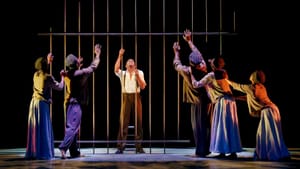Stay in the Loop
BSR publishes on a weekly schedule, with an email newsletter every Wednesday and Thursday morning. There’s no paywall, and subscribing is always free.
The Revelations we still need
The Kimmel Cultural Campus presents Alvin Ailey American Dance Theater

The Alvin Ailey American Dance Theater presented two programs over four late February performances at the Academy of Music. On Friday, February 24, Twyla Tharp’s Roy’s Joys joined two of Ailey’s own works.
Tharp created Roy’s Joys in 1997, inspired by the jazz album Roy Eldridge Vol. II—French Cooking. The choreography, set to Eldridge’s music, is light and breezy, sultry in places and marked by Tharp’s trademark loose hips, relaxed knees, and smooth soft shoe, combined with leaps and intricate lifts that make us gasp. It had a lot going for it, but the nine dancers (in brown pants with striped tops by costume designer Santo Loquasto) seemed hesitant in some of the early formations, as if they were trying not to bump into each other. So as a whole it did not land quite as well as I would have hoped.
But that changed whenever James Gilmer took center stage. Whether in sharp, bravura leaps in a trio with dancers Patrick Coker and Solomon Dumas, or in the intricate, changing positions of his lifts in a duet with Jacquelin Harris, he dominated the stage. All these dancers rose to the challenge, but Harris in particular brought grace and strength to those ever-changing lifts, making it look effortless.
Surviving apartheid
Ailey’s powerful Survivors, inspired by the struggle of Winnie and Nelson Mandela, told a story of grief and endurance. It began with a slow march down the center of the stage, Jeroboam Bozeman in the lead in dark pants, dress shirt, and suspenders. His arms crossed his rib cage, moving as if he were fighting against a strong wind. Behind him came four women in costume designer Toni-Leslie James’s flowing white dresses and hair wraps, except for Belén Indhira Pereyra, as the wife, in red. Two men in boxy grey suits followed. At the back of the stage, hanging ominously over their heads, a set of prison bars caught the yellow spotlight.
Soon the dancers exited, leaving Bozeman alone on the stage. His solo recreated his struggle in pantomime: a duel with an imaginary sword, reaching up with arms straight or curved like wings. In his duet with Pereyra, the pair brought passion to the struggle. When the bars enclosed him, the women of the company came into their own with African dance moves—leaning forward with deeply bent knees, contracting their core as if in anguish. Pereyra was exquisite, bent over her grief or filling the stage, her flowing red skirt spread like a fan with her amazing leg extensions. Her second duet with Bozeman, each on opposite sides of the iron bars, echoed the earlier dance while expressing all their longing and suffering in a tightly compressed space.
The music by Max Roach and Peter Phillips heightened the tension of the dance. Over Roach’s insistent, abrasive drumbeat, the staccato string quartet seemed to act like an aural strobe, capturing movement frozen into poses, as if time had stopped.
Always a new revelation
Before the show began, the woman sitting behind us said that she hoped they were going to do Revelations, and I was happy to assure her that it was on the program. The beloved piece, three movements set to familiar spirituals and depicting the spiritual life of an African American community, seems to grow more loved over the years.

Over that time, I have found my own interest shifting, first enamored of the umbrella dance in “Take Me To the Water.” The women twirled in full, white ruffled dresses, the men in white pants while a woman with a huge white umbrella danced across the rippling waters created by bands of cloth shaken offstage to create the ripples. It is still a lovely piece. “Move, Members, Move” brought the whole company to the stage for a church picnic, the women in long yellow dresses and the men in dark pants, snug dress shirts, and gold vests. Behind them, a backdrop bathed in yellow highlighted a huge sun, fading into blues of a summer moon. The movement echoed social dancing of a bygone day, the men throwing their chests out and the women hiding behind their fluttering palm leaf fans.
But increasingly I am drawn to the first movement, “Pilgrims of Sorrow.” Here, the dancers clustered tight at the center of the stage in dun-colored dresses and pants, their arms outstretched to the sides like an offering gilded by the light, or reaching up, fingers splayed as if beseeching the heavens. In a duet to “Fix Me Jesus,” Sarah Daley-Perdomo seemed to fall, beyond strength, into the arms of Gilmer, who lifted her up again and again. It never ceases to move me.
On Saturday evening and Sunday afternoon, audiences saw Kyle Abraham’s Are You in Your Feelings, and Jamar Roberts’s In a Sentimental Mood, along with the fan favorite Revelations.
What, When, Where
Roy’s Joys, Survivors, Revelations, Are You in Your Feelings, and In a Sentimental Mood. Choreography by Twyla Tharp, Alvin Ailey, Jamar Roberts, and Kyle Abraham. Alvin Ailey American Dance Theater, presented by the Kimmel Cultural Campus. $25-$89. February 24 through 26, 2023, at the Kimmel's Academy of Music, 240 South Broad Street, Philadelphia. (215) 893-1999 or kimmelculturalcampus.org.
Accessibility
Masks are not required in Kimmel Cultural Campus venues.
The Academy of Music is a wheelchair-accessible venue. Patrons can purchase wheelchair seating or loose chairs online by calling patron services at (215) 893-1999, or by emailing [email protected]. With advance notice, patron services can provide options for personal care attendants, American Sign Language, Braille tickets and programs, audio descriptions, and other services.
Sign up for our newsletter
All of the week's new articles, all in one place. Sign up for the free weekly BSR newsletters, and don't miss a conversation.

 Camille Bacon-Smith
Camille Bacon-Smith